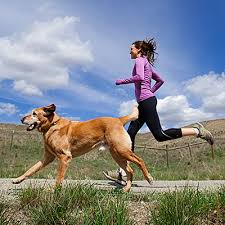
Humans and carnivores thrive mentally, physically and emotionally when exercise is incorporated into their lifestyle on a daily basis. Carnivores were meant to move daily. Their ancestors the wolf evolved to track prey over several miles then take it down with great force and energy, so dogs need daily walks or jogs, and some intense exercise as well.
Proper exercise at the right stage of development can affect the overall condition and structure of a dog. Fast development without muscle development at the same time can result in a dog with straight angles. These dogs generally tend to have more bone, joint and muscle problems such as arthritis and osteoarthritis. The first 8 months of a dog’s life are most important when it comes to exercise.
Dogs have two circulatory systems, one for blood and one for lymph. Lymph are nodes throughout the dog’s body that remove toxins by cleansing the fluid around the cells. They are part of the immune system. Lymph fights infection, removes bacteria and transports fat from the small intestine. It is known as the elimination organ. The more exercise you get the better the circulation is of blood and lymph. Daily lymph only moves when the body moves, and that is by daily, moderate exercise in fresh air and sunshine.
Before embarking on any exercise routine, there are several factors to take into consideration. Is your dog overweight? Does he have any medical conditions? Does he have any old injuries? Is he getting on in years? All these factors should be taken into account before you start exercising with your dog. A vet can help you determine your pets health and fitness level and can suggest appropriate exercise levels. Be creative in designing an exercise plan for your dog and vary his activity to give him a wide range of physical activity and to keep it fun and exciting.

Benefits of Exercise
Exercise helps keep your pet at a healthy weight. Commercial, processed diets are high in carbs and low in actual nutrients so they need to run and play throughout the course of the day to keep their bodies toned and lean. Exercise helps keep your dog’s weight under control.
Elimination becomes more regular. Exercise helps reduce digestive issues and constipation.
Older dogs become less achy and their brains perform better. Getting more oxygen circulated builds the lungs and heart, overall muscle tone and general health improves immensely. Exercise helps keep dogs of all ages agile and limber.
A tired dog is a happy, well behaved dog. Exercise helps dogs get the proper rest that they require, rather than being restless at bedtime or when the family is ready to relax. Exercise helps reduce or eliminate behavioral problems such as excessive barking, digging, chewing and hyperactivity.
Exercise helps shy, timid or fearful dogs gain confidence and helps build trust in your relationship.
There are many different types of exercise that you can do with your dog. Find one that both of you enjoy and can do together.
Canine dog sports are an excellent form of exercise and bonding for both you and your dog.

Agility is a sport in which the handler directs their dog through an obstacle course in a race for both time and accuracy. Dogs run off leash, no food or toy incentives allowed, and the handler cannot touch the dog or the obstacles. The handler’s controls are limited to voice, movement and body language which requires exceptional training of the animal and coordination and direction of the handler. In a competition, the handler must access the course, usually in a 10 minute period, to decide on handling strategies to direct the dog through the course with precision, speed and accuracy. Agility is the most popular dog sport worldwide and with good reason. Dogs and handlers love it!! Agility requires a great deal of time, training and dollars to compete. It is an excellent form of exercise and a wonderful bonding experience for both you and your dog.
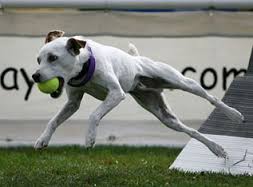
Fly ball-Another popular and excellent form of exercise is the sport of Fly ball. Fly ball is a relay race with teams of four dogs. The dogs race against each other over a series of low jumps to a spring loaded box that releases a tennis ball when the dog hits it with their front paws. The dog must catch the ball and then run back to his handler with it. Each dog must return the ball all the way across the start line before the next dog crosses. Penalties are applied to teams if the ball is dropped or if the next relay dog is released early. The first team to have all four dogs cross the finish line wins the heat. It is a fast and intense sport.
![]()
Tracking – encourages dogs to make use of their strongest faculty, their nose. The objective is for the dog to find the lost track layer and any articles that person may have dropped along the track. On the day of the trial, a track layer follows a designated path, leaving personal items as specified by a judge. The track is then aged or allowed to sit for a period of time, as determined by the organization and level of competition. Then the dog and handler are directed to follow the track. In general, a dog must work consistently without assistance from the handler, and find the required number of lost articles to be awarded a passing score. You don’t have to compete in competition tracking to enjoy it. You can lay your own tracks in your backyard, a park or field.

Chase and Fetch – is one of my favorite games to play with dogs. It gets both of our heart rates up, is fun, and is a great workout. Any type of toy works for fetch, a ball or tug toy are two of my favorites. I will run from my dog and allow him to chase me. Once he is chasing me I will then turn and chase after him. It keeps him guessing. He never knows if he will be the prey or predator.

Tug of War-When it comes to pure, interactive fun nothing compares to a good game of tug. Try to pick a tug toy that your dog will enjoy. For example, a bird dog might like something that flutters when you pull it along. A terrier might like a tug toy that squeaks like a vermin. A ball crazy dog would enjoy a rope toy with a ball attached to it. Use your imagination and come up with a toy that has natural appeal for your particular breed of dog. If you teach your dog to tug you also need to teach him to release the toy on cue. Don’t worry about controlling the game by winding up with the toy every play session, you always have the ultimate control. If you won’t play anymore, then there is no game! Nobody likes a bore! Let your dog win sometimes!
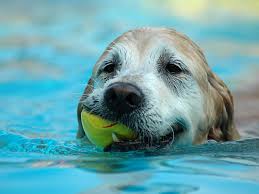
Swimming – Some breeds of dog naturally love to swim, but even those who are not bred to swim can enjoy it every now and then. It is a good idea to acclimate your dog to water at an early age. You always want to make sure that their first experience is a pleasant one. This will allow them to be more confident swimming as a adult. Never force your dog to go into the water if they are scared or reluctant. Wade with your puppy in shallow water in the beginning and be sure to encourage and praise. Don’t allow them to jump into deep water until they are confident. Never allow your dog to swim unsupervised in swimming pools and always be sure that they know how to get out of the pool on their own. If swimming or boating on lakes or rivers, get your dog fitted for a canine life vest. A session in the pool or lake is a great way to maintain fitness or regain condition after a injury.
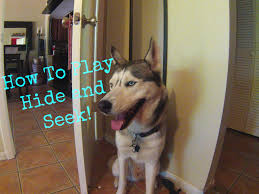
Hide and Seek- Hide and seek is a great game to play both indoors on a rainy day or outside in the fresh air and sunshine. If we play in the house I will place my dog in a stay and go and hide. I hide in closets, under the bed and in different rooms throughout the house. When hidden, I will call out her name and command her to come. When she finally finds me I will jump out of my hiding place and turn and chase her. If we play outside we play in a safe, fenced in area. Never play near a busy road or high traffic area.
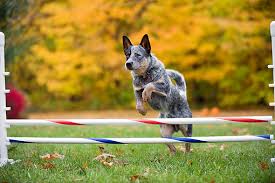
Jumping-Most dogs naturally love to run and jump. Once your dog has acquired basic jumping skills, you can play an endless array of jumping games in the park or in your very own backyard. To be an accomplished jumper your dog must be able to jump with speed, clear the jump without knocking it over or bumping into it and be able to take the jump from any angle. When first teaching your dog to jump, be sure to teach him with a jump height that is quite low. Puppies can be injured if they jump before their growth plates have closed. For teaching young puppies and toy breeds how to jump, you can just lay a bar, a broom or piece of PVC pipe on the ground. Even mature dogs should initially be taught to jump at a low level. The easiest and quickest way to teach your dog to jump is to begin by placing him on leash. Take a treat or toy, whatever best motivates your particular dog, and toss it over the object you would like him to jump over. Toss the treat or toy a few feet away from and over the jump. Give your dog a command, such as over, jump or hup, and walk with him leading him over the jump. Once he goes over the jump, he may retrieve his treat or toy as his reward. Tell him verbally what a great job he did by praising him verbally. Once your dog is going over the jump several times in a row, take the leash off, give your jump command and watch your dog jump over all on his own. Once he has mastered jumping you can build your own jumps made from PVC pipe. You can set up all kinds of obstacle courses from beginner to difficult. Jumping is a big part of dog agility. If you want to learn more contact your local kennel club or professional dog trainer for classes. Leerburg carries some fun DVD’s on agility for both novice , open and excellent levels.
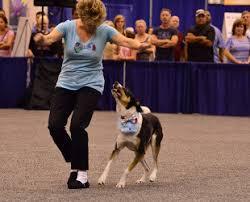
Freestyle Dance- In order to participate in freestyle dance, your dog will need to have a grasp of basic obedience commands. You and your dog do not need to be professional dancers or obedience stars, but they will need to know how to heel on command, sit and lie down. These basic commands are the basis for learning the dance routines. A dog who enjoys trick training may also be a natural at freestyle. You can choose any type of music you like. Experiment with different types of rhythms and beats and see which ones in particular seem to motivate you and your dog. Some pet owners enjoy freestyle as a hobby or as a competitive event, but it has to be something you and your dog enjoy doing together a team. Some of the steps that you and your dog will be performing are stepping backwards and forwards, pivoting, doing circles and spirals, and precise heeling on both your left and right side. It is a great exercise, especially for the hindquarters, and requires some coordination on both your parts. Many kennel clubs offer classes in freestyle dance and there are many How to videos on U Tube, as well as books and DVD’s to help get you started.
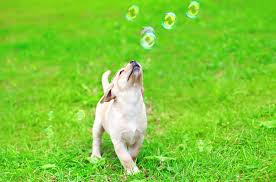
Chasing Bubbles-This is a good exercise for senior dogs or dogs who are not physically able to run far or jump high. This is great mental exercise for dogs, it builds enthusiasm while developing the mind and most dogs enjoy chasing the bubbles. It is very easy to teach your dog to chase bubbles. If they will not automatically do it on their own begin by getting your dogs focus and attention and start by blowing a couple of bubbles at a time while showing and pointing them out to your dog. This is a game that can be enjoyed outside in the yard or on the patio. It is also great indoor entertainment on a rainy or snowy day. This activity is great exercise for tiring out a rambunctious dog with a lot of energy. Homemade bubble recipes are easy to make and safe for your dog. You can make your own dish detergent and just add some water. Then all you need is a bubble wand for hours of indoor fun. Just be sure your dog does not try to drink your bubble mixture, keep it out of his reach and do not allow the bubbles to get into their eyes because it could cause irritation.
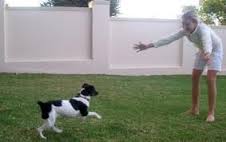
Round Robin Recalls- In order to play round robin your dog needs to have a solid recall (come command). In a secured area, grab a group of at least 3 friends. Stand as far apart as possible for the amount of space you have. Take turns calling the dog to you. When your dog comes reliably when called, be sure to praise him verbally. Take turns having each person call your dog to come. This is a great exercise to work on your off leash obedience as well as your socialization with other people. When your dog runs to you, you can incorporate even more obedience into the game by having your dog sit in front of you when he comes. This makes obedience training fun while exercising both the mind and body.
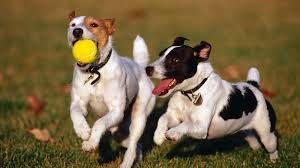
Play Dates-If you have a friend, relative or neighbor that has a friendly dog, play dates can be great fun, socialization and exercise for your pooch. When choosing a playmate, it is best to allow dogs of the same or similar weight to play together. I wouldn’t recommend allowing your 5 lb.Yorkie to play with your neighbors 125 lb Great Pyrenees. Dogs of the opposite sex sometimes get along better with dogs of the same sex. Dogs the same age, depending on the breed, usually will have the same amount of energy. Sometimes allowing puppies to play with seniors, occasionally the senior or older dog may tire of the puppies antics. It is best to allow the play session to take place in a secure, fenced in area. Always supervise play sessions closely, and the supervisor should be a human who both the dogs respect as a pack leader. Use common sense. If you see dogs getting too wound up or showing any signs of aggressive behavior, end the play session immediately. Only incorporate toys once you know for certain that the dogs will play nicely together.

On Leash Walks – On leash walks are great exercise for both owner and dog. On leash walks are good for senior dogs and couch potatoes to get them out in the fresh air and sunshine. If your dog is older or overweight, start off slowly and build up distance over a period of time. If your dog has health problems start off with a ten minute walk and gradually increase duration slowly working up to about 30 minutes. For healthy young and middle aged dogs, a routine walk will not provide enough vigorous exercise. If your dog is in good health, walk briskly for several minutes, then work up into a light jog. People are better suited for long distance jogging than dogs. When dogs in the wild hunt and herd, they move in intense bursts with intermittent stops. Do some short bursts of speed, brisk walking and light jogging, followed by a short rest to stop and sniff around and enjoy the scenery. When jogging with your dog, do not overestimate their abilities and go too far, too fast. If your dog seems sore or exhausted, cut back on the duration or the activity. In the hotter months, walk in the early morning or evening when the sun is not at it’s hottest. Be sure to carry some bottled water for both of you if needed. On very hot days, be sure not to walk on sidewalks or asphalt. Instead opt for grass or softer surfaces. Just like people, dogs can get sore feet and blisters. Be sure to check your dogs pads and paws which can be sensitive.

Frisbee-Playing Frisbee with your dog is a sport that takes a lot of energy and stamina. Your dog needs to be in good physical condition to participate in this game. Running and jumping can place a great deal of stress on joints, and if your breed is prone to hip dysplasia you need to be extra careful. To play the game of Frisbee, your dog will need to know a couple of basic commands, especially the recall. You do not want your dog catching the Frisbee and then taking off with it, running around in a frenzy demanding you to chase and catch him. You will also want to teach your dog the “Drop It” or “Out” command. If he will not relinquish the toy it becomes a game of chase and can be frustrating for the owner who cannot get the flying disc back. Once your dog has mastered catching , retrieving and returning the Frisbee you can add height and distance to your game. There are dog clubs and Frisbee events held all across the country and around the world. This is a great way for dog lovers and disc sport enthusiasts to get together and hone their skills at any level.
It is also important that your dog has already learned at least basic obedience commands, and that you can rely on your dog to return the disc to you and not go dashing off with it. If your dog is still learning how to control the exuberance of youth and is in the training process, give him time to learn self control and obedience before advancing to more complex maneuvers like disc games.

Biking-In order for your dog to bike safely alongside of you, he needs to have a lot of energy and stamina. Biking is a excellent way to get exercise. If your dog is overweight or has any underlying physical conditions then this is not the sport for him. He needs to be in tip top fitness. Just as you need riding gear, so does your dog. You will need a body harness that is well fitted to your dog and a non tangle lead to attach to the harness. You do not want to attach a lead to his neck collar, this could lead to serious injury. They sell reflective or brightly colored vests for dogs. It is recommended that you purchase blinking lights to place on your bike as well as on your dog’s vest, especially at dusk or early morning. You can outfit your dog in hiking booties if you are riding on rough terrain or hot or cold asphalt. A bike baton or lead that you attach to the body of the bike and your dog allows you to be able to keep both hands on the steering wheel. This also helps keep him out of the way of the bike wheels and running at a safe distance. Be sure to bring an additional 6 foot lead if you want to do some walking and sniffing on your excursion. Be sure to pack a collapsible water bowl with filtered drinking water in a backpack for water breaks.

Warm Up and Cool Down- Always warm up and cool down your pet after exercise. To warm up, a quick jog or game of tug will kick start his heart and get his blood pumping. This will get him ready for action. A gentle massage after a run will help them cool down and give you the opportunity to check areas for tenderness and weakness. When massaging an area, take it slow and steady at first. Watch your dog for signs of discomfort and only massage an area if your dog is open to it.






